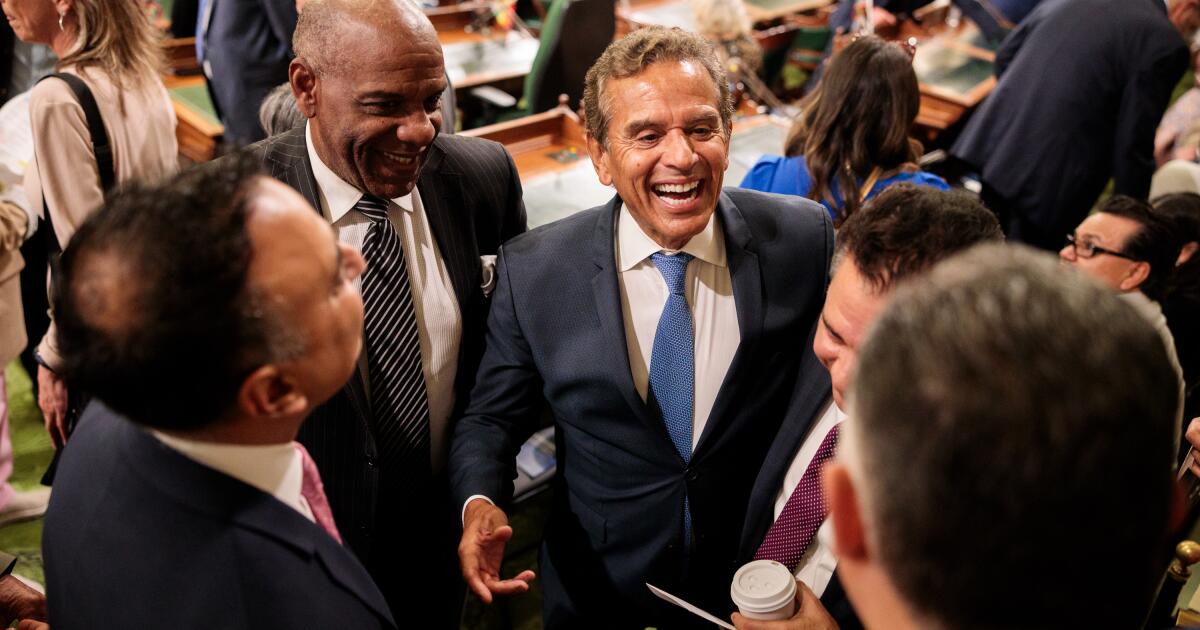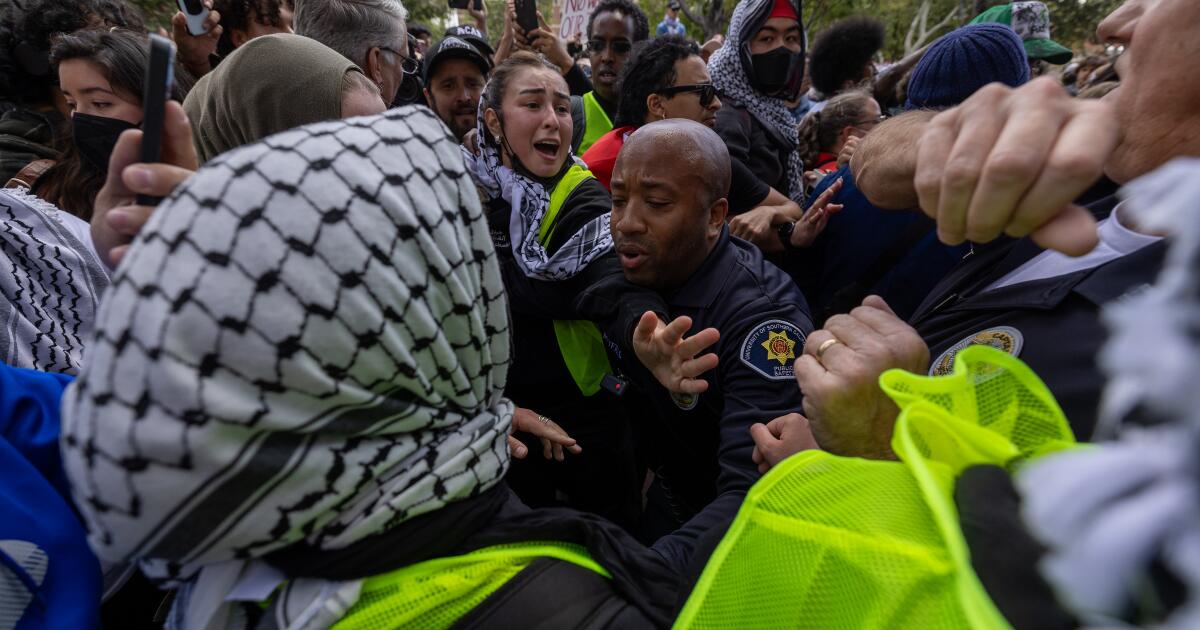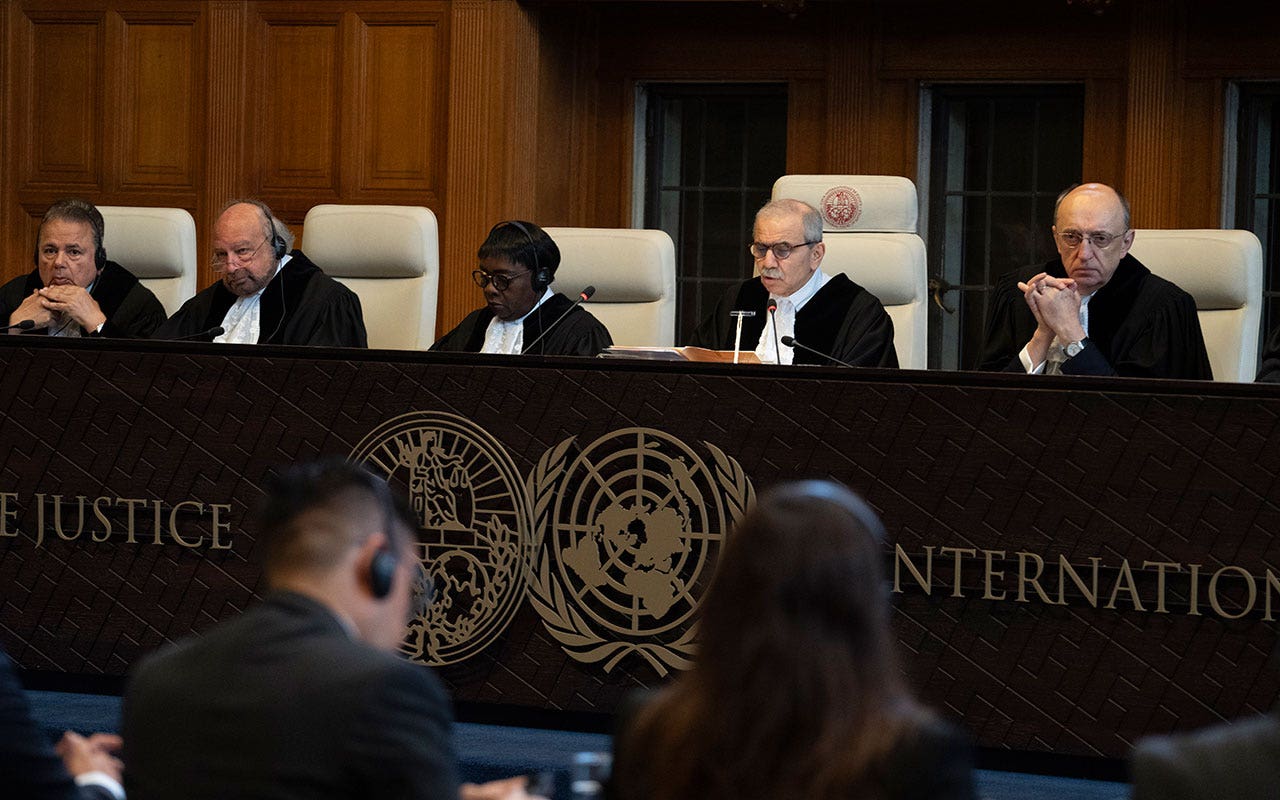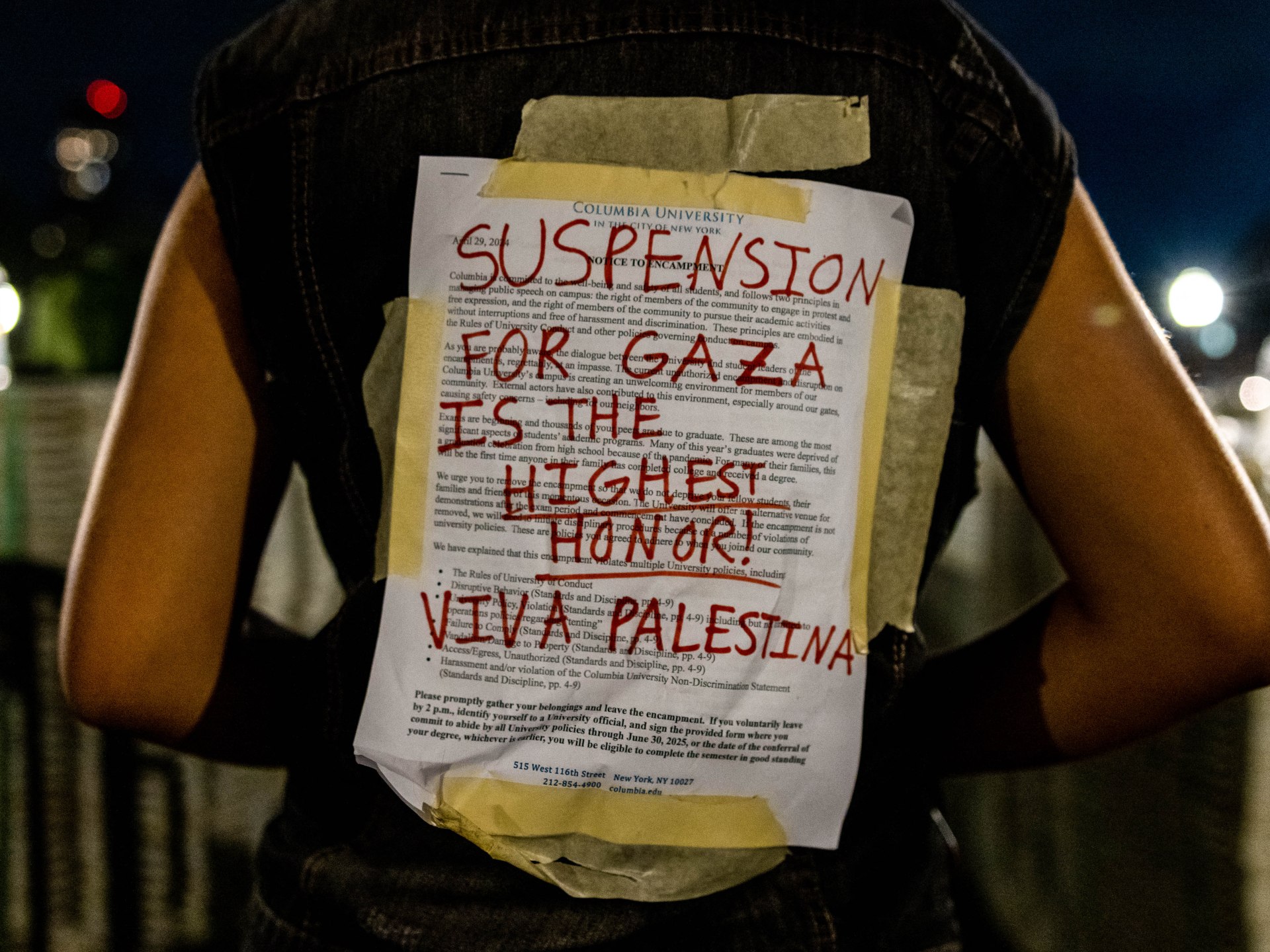Business
Google employees stage sit-ins to protest company's contract with Israel

Dozens of Google employees held sit-ins Tuesday at the tech giant’s New York City and Sunnyvale, Calif., offices to protest the company’s work with Israel.
Google and Amazon have a cloud computing and artificial intelligence contract with the Israeli government and military, a deal known as Project Nimbus that is worth $1.2 billion.
The employees participating in the sit-ins wore shirts that said “Drop Project Nimbus” and a banner was hung that read, “No tech for genocide.”
Protesters sat in the office of Google Cloud Chief Executive Thomas Kurian on Tuesday and remained there for about 10 hours, according to the group.
They demanded Google and Amazon drop Project Nimbus and stop the “harassment, intimidation, bullying, silencing, and censorship” of Palestinian, Arab, Muslim Google workers who have expressed concerns about the company’s work in Israel and the Hamas war.
On Tuesday night, Google ordered the arrest of nine workers in Sunnyvale and New York, who were told they would be locked out of their accounts and offices and were not expected to return to work until contacted by HR, according to a statement from the No Tech for Apartheid campaign.
Officers arrived at a Google facility in Sunnyvale around 10:30 a.m. after getting a call from Google about the protest and saw around 80 participants, wrote Capt. Dzanh K. Le in an email on Tuesday night.
Most of the participants left the area around 12:45 p.m., with five protesters remaining, Le added. When the protesters refused to leave at around 6:30 p.m., they were “arrested without incident for criminal trespassing,” Le wrote.
In a statement, the group of workers who were arrested said they had asked to speak to the Google Cloud CEO but were denied .
“Google executives have ignored our concerns about our ethical responsibility for the impact of our technology as well as the damage to our workplace health and safety caused by this contract, and the company’s internal environment of retaliation, harassment, and bullying,” the workers said in a Wednesday statement. .
Four people were arrested for trespassing at the Google office in New York, according to the New York Police Department.
Google last month fired a worker who protested a speech by Google’s top executive in Israel at a conference in New York.
“As a Software Engineer in Google Cloud, it is horrifying to think that the code I write could be used by the Israeli Military in the first ever AI powered genocide,” said Google Cloud software engineer William Van Der Laar from Sunnyvale in a statement. “We did not come to Google to work on technology that kills. By engaging in this contract leadership has betrayed our trust, our AI Principles, and our humanity.”
Google, based in Mountain View, Calif., did not immediately respond to a request for comment.
Google told Time magazine this year that its Nimbus contract is for work related to Israeli government ministries such as finance, health, transportation and education.
“Our work is not directed at highly sensitive or classified military workloads relevant to weapons or intelligence services,” a Google spokesperson told Time.
Other tech workers, including at Amazon, have voiced concerns about their employers’ involvement in Project Nimbus.
The protests in the tech industry have escalated in the wake of Israel’s bombardment of the Gaza Strip in response to the Oct. 7 attack on Israel by Hamas-led militants in which about 1,200 people were killed and about 240 taken hostage.
More than 33,000 Palestinians in Gaza have been killed in Israel’s air and ground offensive, according to Gaza health officials.

Business
Former L.A. Mayor Antonio Villaraigosa joins cryptocurrency company Coinbase as adviser

Former Los Angeles Mayor Antonio Villaraigosa doesn’t own any cryptocurrency — at least, not yet. But he’s about to become a player in the industry’s push for friendlier cryptocurrency rules.
The trading platform Coinbase announced Tuesday that Villaraigosa, a Democrat who was mayor of Los Angeles from 2005 to 2013, is taking a paid position with its global advisory council.
In an interview with The Times, Villaraigosa said that he won’t be lobbying on behalf of Coinbase but that he is advising the company on securing a “robust, fair regulatory framework” for American customers.
Villaraigosa will focus on how to make financial systems more equitable for Black and Latino customers, Coinbase said. The company estimated that about 41% of American crypto investors are Black and Latino.
“Crypto users participate in our democracy like anyone else,” Villaraigosa said. “They need regulatory protection.”
Villaraigosa’s hiring is part of a broader publicity and lobbying effort by Coinbase after years of conflict between the industry and federal regulators, including the Securities and Exchange Commission.
Criminal investigations have recently taken down two of the best-known figures in the crypto industry: former FTX Chief Executive Sam Bankman-Fried, who was sentenced to 25 years in prison in March, and former Binance Chief Executive Changpeng “CZ” Zhao, who is scheduled to be sentenced Tuesday after pleading guilty last year to a money-laundering charge.
Coinbase and other firms have argued that the U.S. should be friendlier to the industry and that clearer rules are necessary to help American crypto companies compete with exchanges in countries with laxer regulations.
The industry has been spending heavily in the 2024 election cycle, signaling its willingness to boost candidates who support crypto priorities in Washington and oust those who don’t.
The policy advisory council that Villaraigosa is joining includes former Rep. Tim Ryan of Ohio, a Democrat, and former Pennsylvania Sen. Pat Toomey, a Republican, as well as political veterans such as John Anzalone, the pollster for Hillary Clinton’s campaign in 2016 and President Biden’s campaign in 2020.
Villaraigosa brings to the group a “feel for the body politic,” said Faryar Shirzad, Coinbase’s chief policy officer.
He “understands broader public attitude, public opinion, public sentiment, in a way that has been really helpful,” Shirzad added.
Villaraigosa said he would be helping with Coinbase’s efforts to push for a “level playing field,” including for stablecoin, a form of cryptocurrency that is ostensibly pegged one-to-one to the value of the U.S. dollar or an asset like gold.
Villaraigosa said crypto is a promising alternative for Black and Latino investors who have faced racial discrimination at traditional banks. He added that crypto platforms could also serve as an alternative for people who send money to family members in other countries, known as remittances.
People in the United States sent more than $81 billion abroad in 2022, according to the World Bank. The average fee for a $200 remittance payment across the world was 6.18% in the third quarter of last year, the organization said.
The cost to send money to family members through crypto platforms like Coinbase is “de minimis,” or minor, in comparison, Villaraigosa said.
Since leaving Los Angeles City Hall in 2013, Villaraigosa has taught at the USC Sol Price School of Public Policy and has worked as a partner at the consulting firm Actum. He mounted a campaign for governor in 2018, finishing third in the primary behind Gov. Gavin Newsom and Republican John Cox.
In 2022, Newsom tapped Villaraigosa to be a top adviser on infrastructure issues, tasked with helping to identify projects that could reap federal funding from Biden’s infrastructure law.
Villaraigosa has also worked as an adviser to Banc of California, the multi-level marketing company Herbalife and the AltaMed chain of health clinics.
Business
Column: Calling the police on campus protests show that college presidents haven't learned a thing since the 1960s

Students are massed peacefully on campus, making politically charged demands on university presidents. The police are summoned, leading to mass arrests and even to violence — and to the collapse of confidence in the administration.
You may see the punchline coming: This picture isn’t drawn from USC and Columbia University of the present day, but Berkeley in 1964.
The lessons should be obvious. Bringing police onto a college campus on the pretext of preserving or restoring “order” invariably makes things worse. It’s almost always inspired not by conditions on campus, but by partisan pressure on university administrators to act. Often it results in the ouster of the university presidents who condoned the police incursions, and sometimes even in the departure of the politicians whose fingerprints were on the orders.
Arresting peaceful protestors is also likely to escalate, not calm, the tensions on campus — as events of the past week have made abundantly clear.
— ACLU
In other words, nobody wins.
Perhaps in recognition of the astonishing ignorance of college administrators of their own responsibilities, the American Civil Liberties Union last week issued a succinct guide on how to fulfill their “legal obligations to combat discrimination and … maintain order” without sacrificing the “principles of academic freedom and free speech that are core to the educational mission.”
The ACLU advises that administrators “must not single out particular viewpoints — however offensive they may be to some members of the community — for censorship, discipline, or disproportionate punishment.”
It’s one thing for protesters or anyone else to direct harassment “at individuals because of their race, ethnicity, or religion,” the ACLU observed. But “general calls for a Palestinian state ‘from the river to the sea,’ or defenses of Israel’s assault on Gaza, even if many listeners find these messages deeply offensive, cannot be prohibited or punished by a university that respects free speech principles.”
The statement further advised that “speech that is not targeted at an individual or individuals because of their ethnicity or national origin but merely expresses impassioned views about Israel or Palestine is not discrimination and should be protected.” (Emphasis in the original.)
The ACLU cautions that “inviting armed police into a campus protest environment, even a volatile one, can create unacceptable risks for all students and staff.” Its statement points to the history of excessive force wielded by law enforcement units against “communities of color, including Black, Brown, and immigrant students…. Arresting peaceful protestors is also likely to escalate, not calm, the tensions on campus — as events of the past week have made abundantly clear.”
Finally, the statement urges administrators to “resist the pressures placed on them by politicians seeking to exploit campus tensions to advance their own notoriety or partisan agendas…. Universities must stand up to such intimidation, and defend the principles of academic freedom so essential to their integrity and mission.”
The history of campus protests suggests that they generally appear more threatening and disruptive on the spot than they prove to be over time. Strong, ‘decisive’ responses almost always backfire.
Any university administrator contemplating bringing police onto campus must reckon with what happened at Columbia in 1968, when 1,000 New York police summoned to clear student protesters out of the administration building made 700 arrests amid a melee that resulted in injuries of students and police officers alike.
Then there’s Kent State, where Ohio National Guard troops fired on a crowd in 1970, killing four students and wounding nine others, producing images of the confrontation that remain indelible today.
That brings us back to Berkeley. The free speech movement that originated at Berkeley in 1964 culminated in the student takeover of Sproul Hall on Dec. 2, following a speech by student leader Mario Savio in which he said, “There is a time when the operation of the machine becomes so odious, makes you so sick at heart, that you can’t take part.”
When UC President Clark Kerr failed to take action, Gov. Edmund G. “Pat” Brown stepped in, ordering police to clear the building. This resulted in 773 arrests, the largest mass arrest in California history.
Brown plainly was reacting to pressure from conservatives, who would come to include Ronald Reagan, who based his 1966 campaign for governor on sniping about “the mess at Berkeley.” Reagan beat Brown in a landslide, and subsequently orchestrated Kerr’s firing.
The wisdom of avoiding confrontations between law enforcement and campus protesters was lost on Linda Katehi, then-chancellor of UC Davis, who in 2011 allowed campus police to clear an encampment linked to the Occupy movement, which protested economic inequality.
A video of a campus officer casually pepper-spraying students seated on the Davis quad went viral; Katehi never fully regained her standing on campus and lost her chancellorship in 2016.
Judging from the responses to the Gaza-related protests on its campuses, UC itself seems to have absorbed the lessons of the past. Pro-Palestinian protests at UCLA, UC Berkeley and UC Santa Barbara have been tolerated by their administrations, as my colleague Teresa Watanabe has reported, and to date haven’t resulted in confrontations with law enforcement.
That may be the product of the 2011 episode, which yielded a systemwide review and report outlining best practices for dealing with campus protests. The report called for “a substantial shift away from a mindset that has been focused primarily on the maintenance of order and adherence to rules and regulations to a more open and communicative attitude,” with police force used as the very last resort.
That’s not the case at Columbia, USC or some other universities where police have been deployed almost as the first resort. At USC, police in riot gear made 93 arrests April 24 in clearing a protest encampment.
The university has failed to get its arms around the protests; its missteps began with its cancellation of a commencement speech by its valedictorian, Asna Tabassum, a Muslim, over unidentified “threats.” Since then, the university has doubled down by canceling its main commencement ceremony. Numerous speakers tapped for keynote speeches at other academic commencements have canceled their appearances.
Some university leaders may be trying to demonstrate a strong hand in managing their campuses, but the message they communicate is the opposite. “They look weak, they look mostly like they are appeasing hostile outsiders who have no intention of being appeased,” Timothy Burke, a professor of history at Swarthmore College, has written.
Texas Gov. Greg Abbott, for example, bragged in 2019 of signing “a law protecting free speech on college campuses.” But he responded to an encampment at the University of Texas by saying the demonstrators “belong in jail” and “should be expelled,” an indication that his devotion to free speech is selective. State and local police raided the encampment, arresting 57.
If the history of appeasement doesn’t sufficiently teach that appeasement never works, the actions of today’s cynical goons such as Abbott, Rep. Elise Stefanik (R-N.Y.) and House Speaker Mike Johnson (R-La.) demonstrate that they aren’t in this game to be appeased.
They don’t care a hoot about the “safety” of students, or about the rise of antisemitism nationally, or about hurtful rhetoric emanating from the tent colonies on campus, which they claim to be their concerns. Instead, they’re trying to exploit what appears to be a violent situation to pursue their larger campaign to demonize higher education — in fact, education generally — by softening it up for the imposition of right-wing, reactionary ideologies.
One would hope that this message hit Columbia President Minouche Shafik squarely after she staged a show of forcefulness April 18 by calling on the New York Police Department to clear an encampment on that campus’ central lawn; officers in riot gear arrested 100 individuals. That came the day after Shafik faced a lengthy grilling by Stefanik and other Republicans on a House committee about reported antisemitic incidents on and around the Manhattan campus. (Disclosure: I hold a Columbia graduate degree.)
Shafik’s appeasement was unavailing. Three days after the police incursion, Stefanik called on Shafik to “immediately resign” for having “lost control” of the campus. Speaker Johnson followed up three days later by visiting Columbia and also calling on Shafik to resign “if she cannot immediately bring order to this chaos.”
Shafik is still trying to show a strong hand. Columbia’s efforts to clear the encampment occupying a corner of its campus lawn has been excessively punitive: Students who have been suspended in connection with the encampment have been barred from campus facilities, including its libraries, classrooms and the common spaces of their dorm rooms.
Monday, participants in the protest were given until 2 p.m. to clear out and identify themselves to campus police, on pain of suspension that would prevent them from taking final exams or graduating, if they were scheduled to do so this year.
The politicians issued their calls for action after fostering the impression that the campus protests are violent. In the case of Columbia and USC, this is largely a fiction. The Columbia encampment was “fairly calm” and reports that Jewish students feared for their safety “ridiculous,” Milène Klein, a Columbia senior and member of the opinion page board of the Daily Spectator, the campus newspaper, told Slate.com on April 22.
The police presence was what created the tension, Klein said. “We have prison buses around campus, and an egregious amount of police officers off and on campus,” she said. “The presence has been very overwhelming.”
As my colleague Lorraine Ali points out, media coverage of the campus demonstrations and the official responses has tended to erase the goal of the protesters, which is to focus attention on the carnage in Gaza.
But that’s only one casualty of the misdirected coverage. Another is the conflation of anti-Israel sentiment with antisemitism. These are not the same thing. To many people appalled by the situation in Gaza — including many American Jews and even Israelis — the issue isn’t Israel as such or Jewishness but the behavior of the Israeli government, or more specifically the Netanyahu regime.
The participants in the tent protests on campus include many Jewish students who see the issues a lot more clearly than the politicians or the media. That won’t change as long as university administrators forget why their institution’s exist — to defend academic freedom and free speech. The effort may not always be easy, but it’s most important when it’s hard.
Business
MLB ghost kitchens to whip up ballpark food for delivery and pickup, courtesy of IHOP

The concept is curious. Turn 347 International House of Pancakes locations nationwide into ghost kitchens that produce ballpark-themed fast food for delivery and pickup.
Ballpark Bites outlets have sprung up seemingly overnight, 44 in California alone, second only to the 76 in Texas. Maybe that’s how ghost kitchens roll.
Major League Baseball is sponsoring the venture, which mirrors the NASCAR Refuel Tenders & Burgers initiative that also utilizes IHOP kitchens — although regrettably neither menu offers the Rooty Tooty Fresh ‘N Fruity. Already, 524 NASCAR Refuel are in place, and the company motto is (of course) “We’re growing FAST!!!”
Attaching hugely popular, deeply American professional sports to a fast-food venture is the brainchild of Virtual Dining Concepts, owned by Planet Hollywood founder Robert Earl. The company website boasts of 3,000 virtual restaurants, 2,000 restaurants, 6 million orders, and — apparently — counting.
The recipe is simple. Offer what folks typically eat at a ballgame or an auto race for less than the exorbitant prices charged at those venues, slather menu descriptions with a heaping helping of cringe-worthy puns and plays on words, and utilize delivery services to get the grub to couch potatoes glued to their favorite televised ballgame or race.
Like most fast-food chains, the menu at every MLB ghost kitchen is identical, right down to sandwiches served on the same soft pretzel bun. The “starting lineup” offers chicken strip sandwiches, hot dogs, a sirloin tips sandwich and a cheesesteak. A combo plate is called “the triple play” and “the closer” is a ball bucket of doughnut holes tossed in cinnamon sugar.
“We understand that not everyone has the opportunity to visit an MLB or [minor league] ballpark, so we wanted to create Ballpark Bites for fans to enjoy a part of that experience from the comfort of their own home, a local park or even at work,” said Karin Timpone, MLB executive vice president and chief marketing officer.
Reaction on social media and traditional media dings MLB for the sameness of the menus. “You’d think a national organization like MLB would lean into the regional specialties of its ballparks, but nope,” SFGate wrote.
Blowback would be inevitable, however, if attempts to replicate favorites unique to specific ballparks failed — if San Francisco garlic fries or L.A. Dodger Dogs or whatever didn’t taste authentic. Furthermore, most regional ballpark offerings are inferior versions of what is available outside the ballpark, like crab cakes in Baltimore, cheesesteak in Philadelphia, barbecue in Kansas City or deep dish in Chicago.
Who is going to seek out a city’s signature culinary offering from MLB prepared in an IHOP presented by Mastercard?
NASCAR Refuel Tenders & Burgers follows the same script with menu descriptions in overdrive. Choose between Talladega, Hot Lap or Full Throttle tenders, the Daytona Firecracker burger or the Checkered Flag chicken sandwich.
Or, as IHOP views them, revenue fuel.
“Our work with [Virtual Dining Concepts] and the three brands we’re implementing will be a growth driver for our restaurants, specifically as we look at non-peak hours during lunch, dinner and late night,” IHOP president Jay Johns said in a statement. “These new brands are relevant for today’s consumer and perfect for our existing equipment and capabilities in our restaurants nationwide.”
Whether ballpark and racetrack food remains appealing enough off site to support hundreds of locations remains to be seen. If it does, plenty of kitchens are available. As of April 3, 1,699 IHOP restaurants operate in the United States.
The state with the most? California, with 225 locations.
-

 World1 week ago
World1 week agoShipping firms plead for UN help amid escalating Middle East conflict
-

 Politics1 week ago
Politics1 week agoICE chief says this foreign adversary isn’t taking back its illegal immigrants
-

 Politics1 week ago
Politics1 week ago'Nothing more backwards' than US funding Ukraine border security but not our own, conservatives say
-

 News1 week ago
News1 week agoThe San Francisco Zoo will receive a pair of pandas from China
-

 World1 week ago
World1 week agoBrussels, my love? The EU single market is not sexy enough for voters
-

 World1 week ago
World1 week agoEU sanctions extremist Israeli settlers over violence in the West Bank
-

 Education1 week ago
Education1 week agoVideo: Dozens of Yale Students Arrested as Campus Protests Spread
-

 Politics1 week ago
Politics1 week agoDemocrats hold major 2024 advantage as House Republicans face further chaos, division


/cdn.vox-cdn.com/uploads/chorus_asset/file/25426860/2147863367.jpg)











